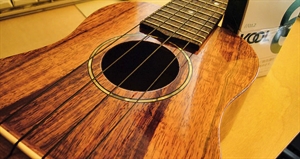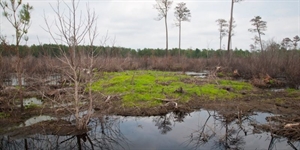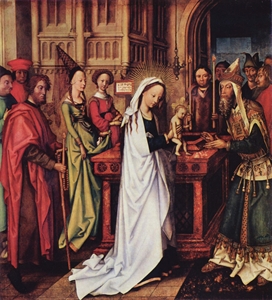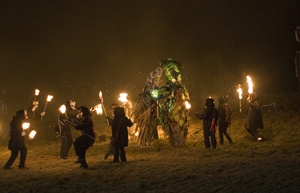Crepe Day or La Chandeleur 2025 is on Sunday, February 2, 2025: Is La Chandeleur celebrated with crepe in Canada?
Sunday, February 2, 2025 is Crepe Day or La Chandeleur 2025. Recipe: Crêpes de la Chandeleur (Candlemas Pancakes) for Candlemas Day Crêpes de la Chandeleur
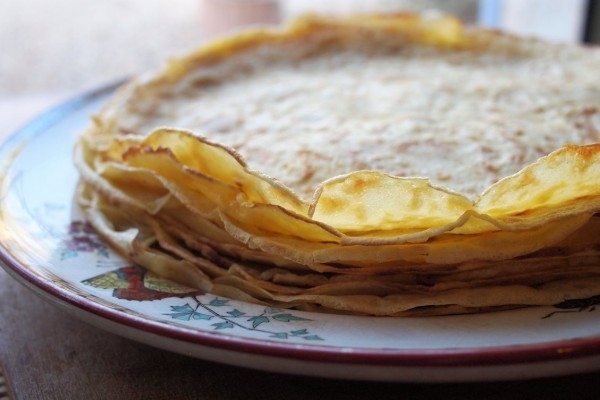
Yes, but only by French Canadian Catholics.
For everyone else, February 2nd is Groundhog Day.

What's the difference between a crepe & a blintz?
CREPE:
A crêpe (pronounced IPA /kreɪp/, French /kʀɛp/) is a type of very thin cooked pancake usually made from wheat flour. The word, like the pancake itself, is of French origin, deriving from the Latin crispa, meaning "curled".
Crêpes are popular throughout Europe, and in some other parts of the world. The common ingredients include flour, eggs, milk, butter and a pinch of salt. Crêpes are usually of two types: sweet crêpes (crêpes sucrées) made with wheat flour and slightly sweetened, and savoury galettes (crêpes salées) made with buckwheat flour and unsweetened. While crêpes originate from Brittany, a region in the west of France, their consumption is nowadays widespread in France. It is said that crêpes were born in this region because they couldn't grow enough wheat to bake bread due to the poor land.
Buckwheat came to Europe from Southwest Asia and also spread to Eastern Europe, where a similar meal called blintz also developed. In Brittany, crêpes are traditionally served with cider. In areas of Central Europe, the meal is called palačinka (Serbian, Czech, Slovak, Croatian and Slovenian), Palatschinken (in Austria), palacsinta (Hungarian), all these terms being derived from Romanian plăcintă (Latin placenta meaning "cake"). Interestingly, an actual Romanian "plăcintă" is actually more similar to a quiche than to a crepe, and the Romanian word for crepe is clătită. In Danish it's Pandekage, in most German regions it's Pfannkuchen. In Dutch pannenkoeken, derived from the words for pan and cake. The Polish version is called naleśniki. In the Spanish region of Galicia, they're called "filloas", and may also be made with pork blood instead of milk.
Crêpes are made by pouring a thin liquid batter onto a hot frying pan or flat circular hot plate, often with a trace of butter or oil spread out evenly across the pan's surface. The batter is spread evenly over the cooking surface of the pan or plate either by tilting the pan or by distributing the batter with a special spatula. The thin layer then thickens and needs to be inverted at least once so that it cooks evenly on both sides.
Crêpes may be rolled or folded, and filled with different ingredients. Common fillings for meal crêpes include cheese, asparagus, ham, spinach, eggs, ratatouille, mushrooms, or various meat products.
When they are sweet, they can be a dessert. They can be filled with various other sweet items: jam, melted chocolate, dairy, ice cream, Nutella (a chocolate and hazelnut paste), bananas, berries, nuts, poppyseeds, cinnamon etc. Popular sweet toppings include sugar (granulated or powdered), maple syrup, lemon juice, whipped cream, fruit spreads, sliced soft fruits, etc.
A more elaborate French and Belgian crêpe is the Crêpe Suzette, a crêpe with lightly grated orange peel and liqueur (usually Grand Marnier) which is subsequently lit.
It is also a fairly common practice to roll or envelope them and then lightly fry, bake or sautée them, not unlike blintz, whose preparation is otherwise similar.
In France, crêpes were traditionally served on Candlemas (La Chandeleur), February 2. This day was originally Virgin Mary's Blessing Day but became known as Crêpe Day, referring to the tradition of offering crêpes. It is believed that if you could catch the crêpe with a frying pan after tossing it in the air with your left hand and holding a piece of gold on your right, you would become rich that year.
Dosa is a crêpe made from rice & lentils in southern India
In Northern Spain, in the regions of Galicia and the Principality of Asturias crêpes are also a traditional dessert. In Galicia they are called filloas, whereas in Asturias they ar known as frixuelos.
In southern Germany, a soup called Flaedle is made from sliced coils of rolled-up savoury crepes.
In some Malaysian cities, as a result of the new malay-franco fusion culture emerging, the crêpe has begun appearing in unexpected forms. Among these is the use of the crêpe as a seal around the fragrant durian.
In Serbia, apart from regular restaurants and home preparation, crepes are sold as fast food in the streets in shops populary known as "palachinkarnice". Dosa is kind of savoury crêpe very popular in South India. It is made from a fermented rice and lentil batter.
**********************************************************
BLINTZ:
A blintz, blintze or blin (plural: blintzes, Russian: блин, блины (pl.) bliny; Ukrainian: млинці, mlyntsi; blini; Yiddish: בלינצע blintse) is a thin pancake (similar to a crêpe) which is often served in connection with a religious rite or festival in several cultures.
[edit]Origins, Culture, and Etymology
The English word blintz comes from the Yiddish "blintse" which in turns come from blin. "Blin" comes from Old Slavic mlin, that means "to mill" (compare the Ukrainian word for blin млинець, mlynets’). Blins had a somewhat ritual significance for early Slavic peoples in pre-Christian times since they were a symbol of the sun, due to their round form. They were traditionally prepared at the end of the winter to honor the rebirth of the new sun (Pancake week, or Maslenitsa). This tradition was adopted by the Orthodox church and is carried on to the present day. Bliny were once also served at wakes, to commemorate the recently deceased.
Traditional Russian bliny are made with yeasted batter, which is left to rise and then diluted with cold or boiling (zavarnye bliny) water or milk just before baking them in the traditional Russian oven (to this day the process of cooking bliny is referred to as baking in Russian, even though these days they are almost universally pan-fried, like pancakes). Blintzes (blinchiki in Russian, considered to be a borrowed dish) are made from unyeasted batter (usually made of flour, milk and eggs) and are nearly identical to French crêpes. All kinds of flour may be used for making bliny: from wheat and buckwheat to oatmeal and millet, although wheat is currently by far the most popular.
Blins were borrowed into Yiddish as בלינצע (blintse) (in German as plinsen) and came into English from the Yiddish form with the spelling "blintz". Blintz were popularized in the United States by Jewish immigrants as blintz are a popular dish in Jewish cuisine. While not associated with any specific religious rite in Judaism, blintzes that are stuffed with a cheese filling and then fried in oil are served on holidays such as Chanukah (oil figures in the Chanukah miracle story) and Shavuot (when dairy dishes are traditionally served).
Blins may be prepared and served in three basic ways.
They may be eaten "as is". In this case the batter may contain various add-ins, from grated potato or apple to raisins. These blini are quite common in Eastern Europe and are more solidly-filled than the spongy pancakes usually eaten in North America.
They may be smeared with butter, bacon fat, sour cream, jam or caviar and possibly folded or rolled into a tube. In that form they are similar to French crêpes. The caviar filling is popular during Russian-style cocktail parties.
(The term "blintz" is mostly applicable to this version): A filling such as jam, fruit, potato, cottage cheese or other cheese, cooked ground meat, cooked chicken and even chopped mushrooms, bean sprouts, cabbage and onions (for a Chinese eggroll-type blintz) is rolled or enveloped into a pre-fried blintz and then the blintz is lightly re-fried, sautéed or baked. Such a blintz is also called nalysnyky in that form (Ukrainian: налисники) or blinchiki (Russian: блинчики).
Buckwheat bliny are part of traditional Russian cuisine, almost forgotten during the times of the Soviet Union. They are still widespread in Ukraine where they are known as hrechanyky (Ukrainian: гречаники).
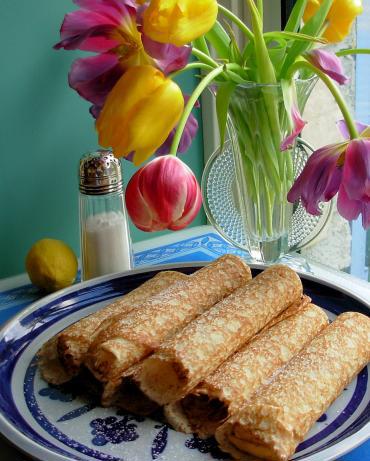
What's the difference between a crepe & a blintz?
CREPE:
A crêpe (pronounced IPA /kreɪp/, French /kʀɛp/) is a type of very thin cooked pancake usually made from wheat flour. The word, like the pancake itself, is of French origin, deriving from the Latin crispa, meaning "curled".
Crêpes are popular throughout Europe, and in some other parts of the world. The common ingredients include flour, eggs, milk, butter and a pinch of salt. Crêpes are usually of two types: sweet crêpes (crêpes sucrées) made with wheat flour and slightly sweetened, and savoury galettes (crêpes salées) made with buckwheat flour and unsweetened. While crêpes originate from Brittany, a region in the west of France, their consumption is nowadays widespread in France. It is said that crêpes were born in this region because they couldn't grow enough wheat to bake bread due to the poor land.
Buckwheat came to Europe from Southwest Asia and also spread to Eastern Europe, where a similar meal called blintz also developed. In Brittany, crêpes are traditionally served with cider. In areas of Central Europe, the meal is called palačinka (Serbian, Czech, Slovak, Croatian and Slovenian), Palatschinken (in Austria), palacsinta (Hungarian), all these terms being derived from Romanian plăcintă (Latin placenta meaning "cake"). Interestingly, an actual Romanian "plăcintă" is actually more similar to a quiche than to a crepe, and the Romanian word for crepe is clătită. In Danish it's Pandekage, in most German regions it's Pfannkuchen. In Dutch pannenkoeken, derived from the words for pan and cake. The Polish version is called naleśniki. In the Spanish region of Galicia, they're called "filloas", and may also be made with pork blood instead of milk.
Crêpes are made by pouring a thin liquid batter onto a hot frying pan or flat circular hot plate, often with a trace of butter or oil spread out evenly across the pan's surface. The batter is spread evenly over the cooking surface of the pan or plate either by tilting the pan or by distributing the batter with a special spatula. The thin layer then thickens and needs to be inverted at least once so that it cooks evenly on both sides.
Crêpes may be rolled or folded, and filled with different ingredients. Common fillings for meal crêpes include cheese, asparagus, ham, spinach, eggs, ratatouille, mushrooms, or various meat products.
When they are sweet, they can be a dessert. They can be filled with various other sweet items: jam, melted chocolate, dairy, ice cream, Nutella (a chocolate and hazelnut paste), bananas, berries, nuts, poppyseeds, cinnamon etc. Popular sweet toppings include sugar (granulated or powdered), maple syrup, lemon juice, whipped cream, fruit spreads, sliced soft fruits, etc.
A more elaborate French and Belgian crêpe is the Crêpe Suzette, a crêpe with lightly grated orange peel and liqueur (usually Grand Marnier) which is subsequently lit.
It is also a fairly common practice to roll or envelope them and then lightly fry, bake or sautée them, not unlike blintz, whose preparation is otherwise similar.
In France, crêpes were traditionally served on Candlemas (La Chandeleur), February 2. This day was originally Virgin Mary's Blessing Day but became known as Crêpe Day, referring to the tradition of offering crêpes. It is believed that if you could catch the crêpe with a frying pan after tossing it in the air with your left hand and holding a piece of gold on your right, you would become rich that year.
Dosa is a crêpe made from rice & lentils in southern India
In Northern Spain, in the regions of Galicia and the Principality of Asturias crêpes are also a traditional dessert. In Galicia they are called filloas, whereas in Asturias they ar known as frixuelos.
In southern Germany, a soup called Flaedle is made from sliced coils of rolled-up savoury crepes.
In some Malaysian cities, as a result of the new malay-franco fusion culture emerging, the crêpe has begun appearing in unexpected forms. Among these is the use of the crêpe as a seal around the fragrant durian.
In Serbia, apart from regular restaurants and home preparation, crepes are sold as fast food in the streets in shops populary known as "palachinkarnice". Dosa is kind of savoury crêpe very popular in South India. It is made from a fermented rice and lentil batter.
******************************...
BLINTZ:
A blintz, blintze or blin (plural: blintzes, Russian: блин, блины (pl.) bliny; Ukrainian: млинці, mlyntsi; blini; Yiddish: בלינצע blintse) is a thin pancake (similar to a crêpe) which is often served in connection with a religious rite or festival in several cultures.
[edit]Origins, Culture, and Etymology
The English word blintz comes from the Yiddish "blintse" which in turns come from blin. "Blin" comes from Old Slavic mlin, that means "to mill" (compare the Ukrainian word for blin млинець, mlynets’). Blins had a somewhat ritual significance for early Slavic peoples in pre-Christian times since they were a symbol of the sun, due to their round form. They were traditionally prepared at the end of the winter to honor the rebirth of the new sun (Pancake week, or Maslenitsa). This tradition was adopted by the Orthodox church and is carried on to the present day. Bliny were once also served at wakes, to commemorate the recently deceased.
Traditional Russian bliny are made with yeasted batter, which is left to rise and then diluted with cold or boiling (zavarnye bliny) water or milk just before baking them in the traditional Russian oven (to this day the process of cooking bliny is referred to as baking in Russian, even though these days they are almost universally pan-fried, like pancakes). Blintzes (blinchiki in Russian, considered to be a borrowed dish) are made from unyeasted batter (usually made of flour, milk and eggs) and are nearly identical to French crêpes. All kinds of flour may be used for making bliny: from wheat and buckwheat to oatmeal and millet, although wheat is currently by far the most popular.
Blins were borrowed into Yiddish as בלינצע (blintse) (in German as plinsen) and came into English from the Yiddish form with the spelling "blintz". Blintz were popularized in the United States by Jewish immigrants as blintz are a popular dish in Jewish cuisine. While not associated with any specific religious rite in Judaism, blintzes that are stuffed with a cheese filling and then fried in oil are served on holidays such as Chanukah (oil figures in the Chanukah miracle story) and Shavuot (when dairy dishes are traditionally served).
Blins may be prepared and served in three basic ways.
They may be eaten "as is". In this case the batter may contain various add-ins, from grated potato or apple to raisins. These blini are quite common in Eastern Europe and are more solidly-filled than the spongy pancakes usually eaten in North America.
They may be smeared with butter, bacon fat, sour cream, jam or caviar and possibly folded or rolled into a tube. In that form they are similar to French crêpes. The caviar filling is popular during Russian-style cocktail parties.
(The term "blintz" is mostly applicable to this version): A filling such as jam, fruit, potato, cottage cheese or other cheese, cooked ground meat, cooked chicken and even chopped mushrooms, bean sprouts, cabbage and onions (for a Chinese eggroll-type blintz) is rolled or enveloped into a pre-fried blintz and then the blintz is lightly re-fried, sautéed or baked. Such a blintz is also called nalysnyky in that form (Ukrainian: налисники) or blinchiki (Russian: блинчики).
Buckwheat bliny are part of traditional Russian cuisine, almost forgotten during the times of the Soviet Union. They are still widespread in Ukraine where they are known as hrechanyky (Ukrainian: гречаники).







